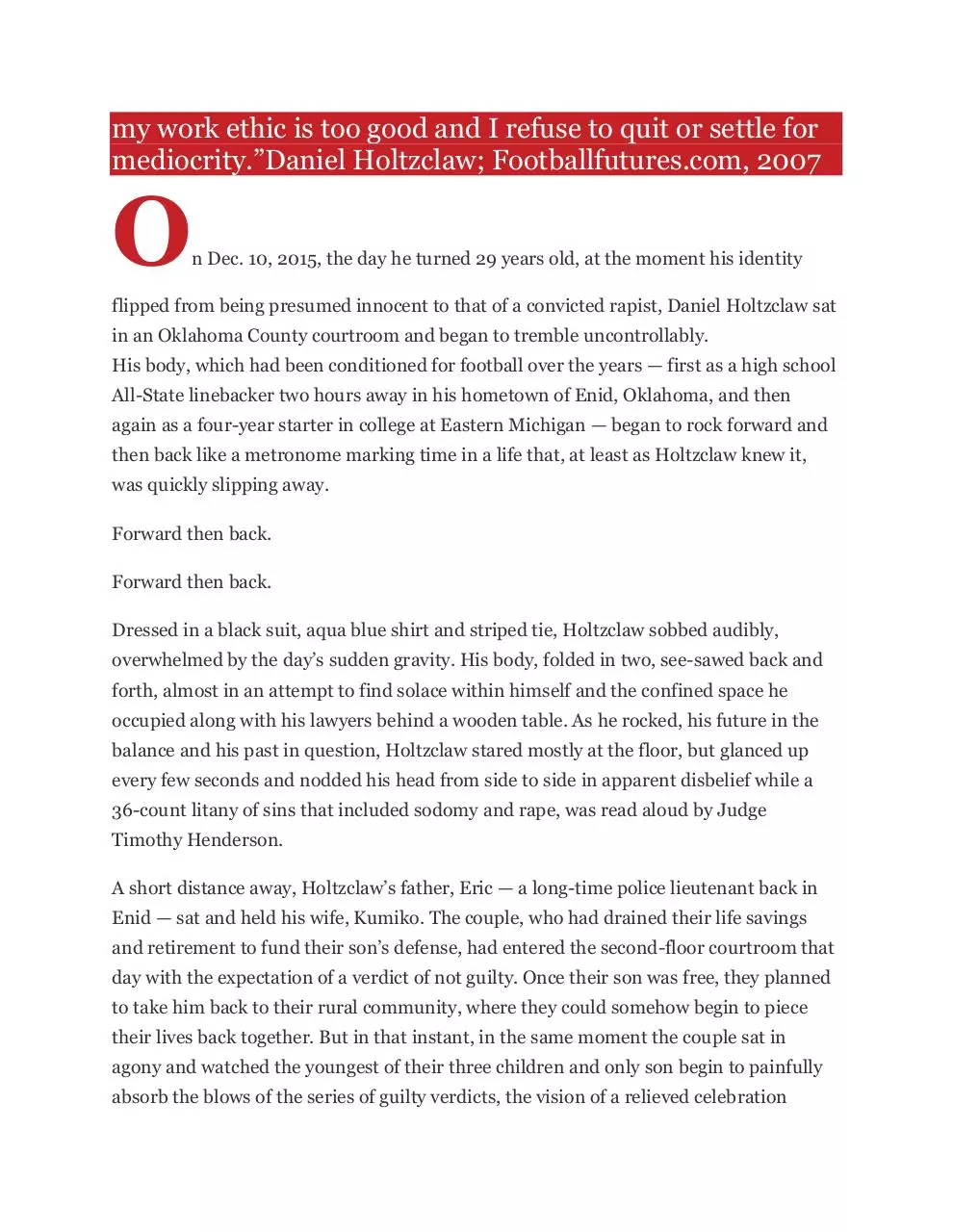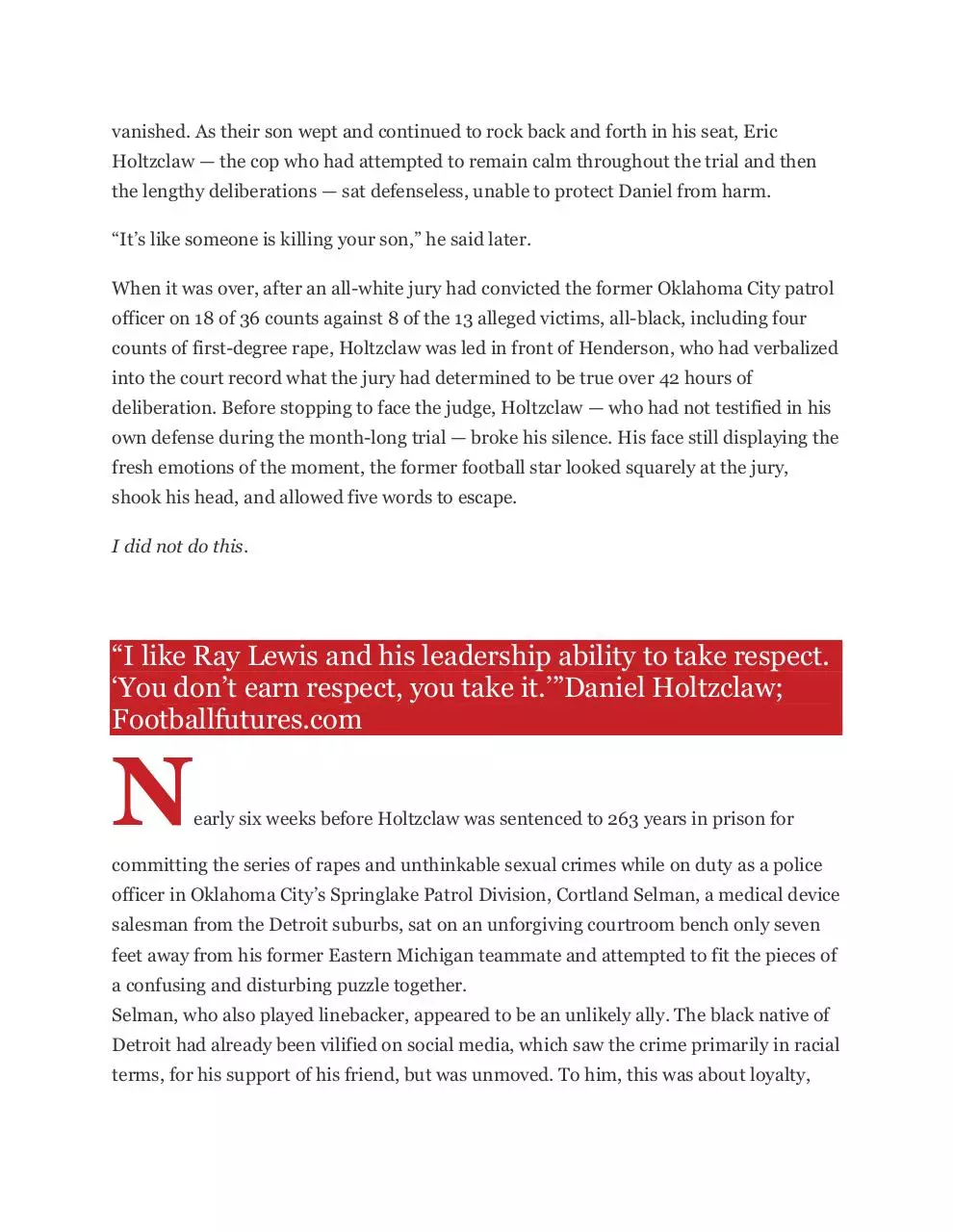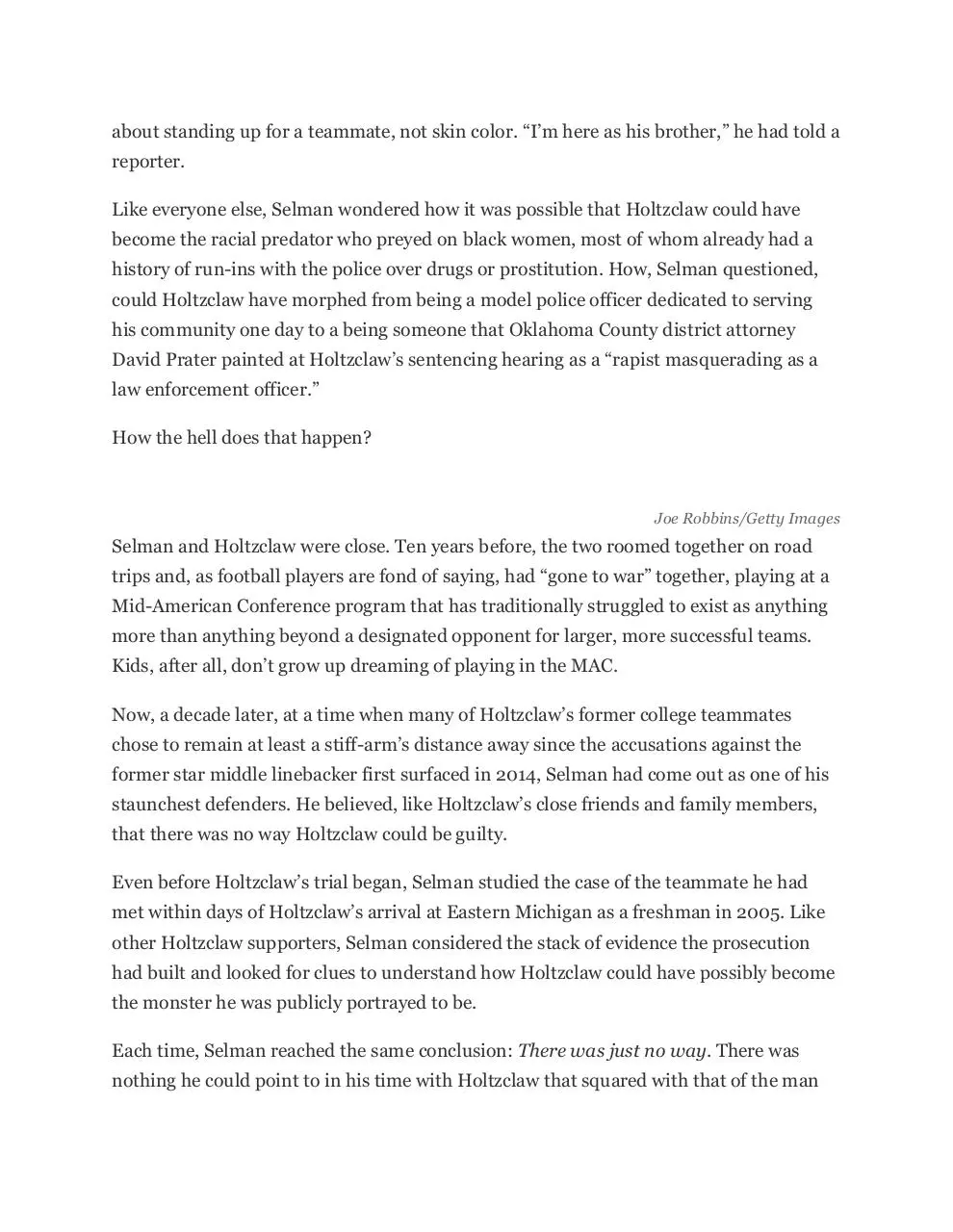SB Nation Who is Daniel Holtzclaw (PDF)
File information
Author: Deb Ruthenberg
This PDF 1.6 document has been generated by Microsoft® Word 2010, and has been sent on pdf-archive.com on 18/02/2016 at 03:59, from IP address 68.97.x.x.
The current document download page has been viewed 2771 times.
File size: 1.17 MB (46 pages).
Privacy: public file





File preview
Jeff Arnold•February 17, 2016
WHO IS
DANIEL
HOLTZCLA
W?
POLICE
OFFICER
“There is no off-field situation that you will ever come
across. I’m a gym rat, I love the game. I will give 110%
every snap, every play. I’m a guy that is very coachable and
can lead on and off the field. I refuse to be a bust because
my work ethic is too good and I refuse to quit or settle for
mediocrity.”Daniel Holtzclaw; Footballfutures.com, 2007
O
n Dec. 10, 2015, the day he turned 29 years old, at the moment his identity
flipped from being presumed innocent to that of a convicted rapist, Daniel Holtzclaw sat
in an Oklahoma County courtroom and began to tremble uncontrollably.
His body, which had been conditioned for football over the years — first as a high school
All-State linebacker two hours away in his hometown of Enid, Oklahoma, and then
again as a four-year starter in college at Eastern Michigan — began to rock forward and
then back like a metronome marking time in a life that, at least as Holtzclaw knew it,
was quickly slipping away.
Forward then back.
Forward then back.
Dressed in a black suit, aqua blue shirt and striped tie, Holtzclaw sobbed audibly,
overwhelmed by the day’s sudden gravity. His body, folded in two, see-sawed back and
forth, almost in an attempt to find solace within himself and the confined space he
occupied along with his lawyers behind a wooden table. As he rocked, his future in the
balance and his past in question, Holtzclaw stared mostly at the floor, but glanced up
every few seconds and nodded his head from side to side in apparent disbelief while a
36-count litany of sins that included sodomy and rape, was read aloud by Judge
Timothy Henderson.
A short distance away, Holtzclaw’s father, Eric — a long-time police lieutenant back in
Enid — sat and held his wife, Kumiko. The couple, who had drained their life savings
and retirement to fund their son’s defense, had entered the second-floor courtroom that
day with the expectation of a verdict of not guilty. Once their son was free, they planned
to take him back to their rural community, where they could somehow begin to piece
their lives back together. But in that instant, in the same moment the couple sat in
agony and watched the youngest of their three children and only son begin to painfully
absorb the blows of the series of guilty verdicts, the vision of a relieved celebration
vanished. As their son wept and continued to rock back and forth in his seat, Eric
Holtzclaw — the cop who had attempted to remain calm throughout the trial and then
the lengthy deliberations — sat defenseless, unable to protect Daniel from harm.
“It’s like someone is killing your son,” he said later.
When it was over, after an all-white jury had convicted the former Oklahoma City patrol
officer on 18 of 36 counts against 8 of the 13 alleged victims, all-black, including four
counts of first-degree rape, Holtzclaw was led in front of Henderson, who had verbalized
into the court record what the jury had determined to be true over 42 hours of
deliberation. Before stopping to face the judge, Holtzclaw — who had not testified in his
own defense during the month-long trial — broke his silence. His face still displaying the
fresh emotions of the moment, the former football star looked squarely at the jury,
shook his head, and allowed five words to escape.
I did not do this.
“I like Ray Lewis and his leadership ability to take respect.
‘You don’t earn respect, you take it.’”Daniel Holtzclaw;
Footballfutures.com
N
early six weeks before Holtzclaw was sentenced to 263 years in prison for
committing the series of rapes and unthinkable sexual crimes while on duty as a police
officer in Oklahoma City’s Springlake Patrol Division, Cortland Selman, a medical device
salesman from the Detroit suburbs, sat on an unforgiving courtroom bench only seven
feet away from his former Eastern Michigan teammate and attempted to fit the pieces of
a confusing and disturbing puzzle together.
Selman, who also played linebacker, appeared to be an unlikely ally. The black native of
Detroit had already been vilified on social media, which saw the crime primarily in racial
terms, for his support of his friend, but was unmoved. To him, this was about loyalty,
about standing up for a teammate, not skin color. “I’m here as his brother,” he had told a
reporter.
Like everyone else, Selman wondered how it was possible that Holtzclaw could have
become the racial predator who preyed on black women, most of whom already had a
history of run-ins with the police over drugs or prostitution. How, Selman questioned,
could Holtzclaw have morphed from being a model police officer dedicated to serving
his community one day to a being someone that Oklahoma County district attorney
David Prater painted at Holtzclaw’s sentencing hearing as a “rapist masquerading as a
law enforcement officer.”
How the hell does that happen?
Joe Robbins/Getty Images
Selman and Holtzclaw were close. Ten years before, the two roomed together on road
trips and, as football players are fond of saying, had “gone to war” together, playing at a
Mid-American Conference program that has traditionally struggled to exist as anything
more than anything beyond a designated opponent for larger, more successful teams.
Kids, after all, don’t grow up dreaming of playing in the MAC.
Now, a decade later, at a time when many of Holtzclaw’s former college teammates
chose to remain at least a stiff-arm’s distance away since the accusations against the
former star middle linebacker first surfaced in 2014, Selman had come out as one of his
staunchest defenders. He believed, like Holtzclaw’s close friends and family members,
that there was no way Holtzclaw could be guilty.
Even before Holtzclaw’s trial began, Selman studied the case of the teammate he had
met within days of Holtzclaw’s arrival at Eastern Michigan as a freshman in 2005. Like
other Holtzclaw supporters, Selman considered the stack of evidence the prosecution
had built and looked for clues to understand how Holtzclaw could have possibly become
the monster he was publicly portrayed to be.
Each time, Selman reached the same conclusion: There was just no way. There was
nothing he could point to in his time with Holtzclaw that squared with that of the man
in trial, or the testimony from the 13 women victims during Holtzclaw’s trial. Their
claims had proven both graphic and disturbing. In each case, women ranging in age
from 17 to 57, most with troubled pasts, claimed that at some point during a six-month
period between late 2013 and the summer of 2014, each was victimized by a cop who
stopped them due to some traffic offense, usually determined their vulnerability due to
past offenses, then forced himself on them sexually in exchange for not making their
legal issues any worse than they already were.
Jannie Ligons, the grandmother whose initial complaint became a focal point of the
state’s case, testified that in the summer of 2014, Holtzclaw pulled her over for erratic
driving at 2 a.m., just as his shift ended. Ligons was was on her way home after playing
dominoes with friends. During the traffic stop, Ligons, who, unlike other Holtzclaw
victims had no criminal record, testified Holtzclaw started to conduct a search during
which he ordered the daycare worker to lift her shirt and then remove her pants.
Holtzclaw, according to Ligons’ testimony, lowered the beam of his flashlight between
her legs before unzipping his pants and ordering her to perform oral sodomy.
“Come on,” Ligons testified Holtzclaw said at the time, “I don’t have all night.”
Believing she might be shot if she did not comply, Ligons did as Holtzclaw ordered. She
later told local media outlets that all she could see at the time “my life flashing in front
of my eyes and the holster on his right side.” In every case, prosecutors maintained
Holtzclaw sexually assaulted and raped his victims believing they would be too
frightened and intimidated to report him. Ligons, however, was not. Her accusations
triggered an internal investigation by the Oklahoma City Police Department’s sex crimes
unit that resulted in the 36 charges Holtzclaw faced in court. It also inspired an
investigation by the Associated Press that found the case was not an anomaly. Over a
six-year period more than 1,000 police officers nationwide had been stripped of their
badges after being found to have committed sexual assaults and rape while on duty.
Following his department’s internal probe, Oklahoma City Police Chief Bill Citty wrote
in Holtzclaw’s termination letter, “Your offenses committed against women in our
community constitute the greatest abuse of police authority I have witnessed in my 37
years as a member of this agency.”
In stark contrast to the state, Holtzclaw’s attorney, Scott Adams, characterized his client
as a model law enforcement officer who was “naïve and very gullible” and who was
trying to better understand the section of Oklahoma City he had been assigned to. He
also attempted to cast Holtzclaw’s victims as being street smart and under the influence
of drugs or alcohol at the time they claimed to have been sexually assaulted. Adams had
based his legal strategy, including the decision not to put Holtzclaw on the witness stand
in his own defense, on the claim a jury would never believe his client’s accusers. In
Adams’ view, Holtzclaw was the victim.
In most instances, it is extremely difficult to convict
police officers of sexual crimes: the police
themselves conduct the investigation and juries
generally find police officers more believable than
their accusers.
Like Adams, Brian Bates, a licensed Oklahoma City-based private investigator and
controversial self-professed “video vigilante,” known for taping prostitutes and johns to
combat human trafficking and licensing the product to news outlets at a profit (his
website is called “JohnTV”), painted Holtzclaw in a similar light. Bates, who spent
hundreds of hours looking into Holtzclaw’s case for Adams, deemed the former football
star to be immature and naïve. He determined that through a series of critical
procedural errors involving the women he came into contact with, Holtzclaw, guilty or
not, nevertheless left himself wide open to be charged with abuse of his authority by
leaving windows of time spent with each woman unaccounted for. In Bates’ view,
Holtzclaw was swept up in the furor over treatment of black Americans by police officers
in other places, turmoil that had already resulted the #BlackLivesMatter movement and
sparked riots in places like Ferguson, Missouri, and Baltimore, a brewing perfect storm
that was only getting worse.
“The emotions were already there and all (the public) needed was a poster child and
Daniel came along at the absolute worst time for Daniel,” Bates said. “And he was done.”
Yet this ignores the fact that in most instances, it is extremely difficult to convict police
officers of sexual crimes: the police themselves conduct the investigation and juries
generally find police officers more believable than their accusers. But the magnitude of
Holtzclaw’s crimes, the evidence that Holtzclaw had indeed come into contact with each
of the women, the surrounding climate, and the veracity of his victims on the stand
delivered a different verdict.
Regardless of the conviction, Selman still refuses to believe that his former college
teammate could have carried out such a sexually deviant plan while working under the
guise of a police officer. The entire time Holtzclaw spent on campus in Ypsilanti,
Michigan, his name had never been associated with trouble. Independent searches and
police and court records confirm that, as do the recollections of former teammates and
university officials alike, none of whom could recall that Holtzclaw had ever made any
serious missteps during his entire Division I playing career. And yet, here Holtzclaw
was, on trial for his life.
Like many of those who hadn’t remained in regular contact with Holtzclaw over the
years, Selman first learned of the allegations against the former freshman All-American
second-hand. On Aug. 22, 2014 — the day Holtzclaw was arrested and — news of the
charges against the then third-year cop broke — Selman’s cellphone started to buzz with
a series of 10 text messages from mutual friends and former teammates. Each included
either a link to a news story or a question wondering whether Selman believed the
reports coming out of Oklahoma City. Selman eventually clicked on one of the links and
started reading in utter disbelief. The headlines were all the same: Oklahoma City cop
arrested held on $5 million bond.
“Jesus Christ,” Selman said.
“I was like, ‘Has Claw gone completely rogue?’ I was like, ‘What happened?’”
He wasn’t the only person who knew Holtzclaw to ask that question. Far from it.
“My negatives? I would have to say everything. I am never
settling for good when I can become great. I always am
trying to have continuous improvement.”Daniel
Holtzclaw; Footballfutures.com
Tyler Grey had just arrived home to his Oklahoma City apartment as a televised report
broke the shocking news of Holtzclaw’s arrest.
Grey, like Holtzclaw, called Enid home and grew up in a place situated somewhere in the
space that exists between an up and coming medium-sized city with all of life’s modern
conveniences and small-town America where everyone still knows everyone else’s
business. Oil and agriculture provide most of the jobs in Enid, and the relatively
prosperous city is home to about 50,000 people — 81 percent of which are white and
only 4 percent black, and only 16 percent living in poverty.
Grey, who played college ball at Northwestern Oklahoma, was a year older than
Holtzclaw during their time on Enid’s varsity football team. As a teenager, the
quarterback had become close friends with Holtzclaw, often spending weeknight
evenings with him and other older teammates playing poker, video games or cruising
along what Enid locals refer to as “The Strip.” The short stretch of South Van Buren St.,
bordered on one end by the Family Video store and by the Sonic fast food restaurant on
the other, is where the rural town’s version of American Graffiti plays out, teenage men
and women cruising the street waiting to grow up.
Copyright 2016 by Eric Holtzclaw. All rights reserved. Used with permission.
Grey describes him and his teammates as straight-laced as they come, well aware that in
a town like Enid, popular athletes were easily identified and often the target of jealousy,
particularly those from prominent families. During his four years in high school,
Holtzclaw fit squarely into that category.
Holtzclaw’s parents both came from law enforcement backgrounds. Eric Holtzclaw
worked for 20 years in the Air Force while serving at the Yokota Air Force Base in
Japan. While there, he met Kumiko, who also worked for the local police force. Daniel
was born in Guam, and after moving to Enid when Daniel was 2, the family settled into
Download SB Nation Who is Daniel Holtzclaw
SB Nation Who is Daniel Holtzclaw.pdf (PDF, 1.17 MB)
Download PDF
Share this file on social networks
Link to this page
Permanent link
Use the permanent link to the download page to share your document on Facebook, Twitter, LinkedIn, or directly with a contact by e-Mail, Messenger, Whatsapp, Line..
Short link
Use the short link to share your document on Twitter or by text message (SMS)
HTML Code
Copy the following HTML code to share your document on a Website or Blog
QR Code to this page

This file has been shared publicly by a user of PDF Archive.
Document ID: 0000340729.